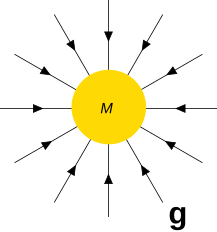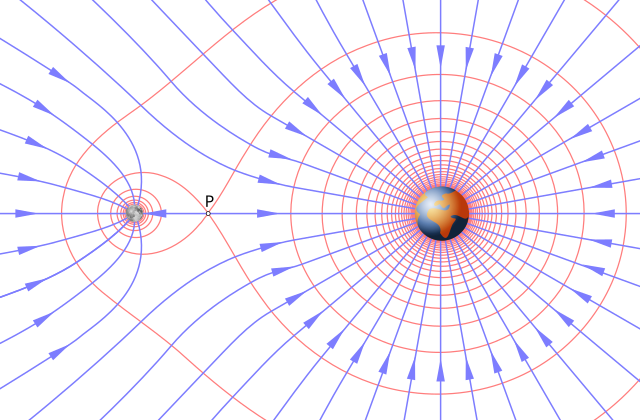OCR Specification focus:
‘Recognise gravitational fields as one form of field that produces forces.’
Gravitational fields provide a framework for understanding how masses interact without physical contact, allowing us to describe forces at a distance with clarity, precision, and predictive power.
Gravitational Fields as Force-Producing Regions
A gravitational field is a region of space where a mass experiences an attractive influence due to another mass. According to the OCR specification, students must recognise gravitational fields as one form of field that produces forces, meaning that masses alter the space around them in such a way that any other mass placed within that region experiences a force. This concept allows us to analyse gravitational interactions without requiring objects to touch or directly communicate through material connections.
The central idea is that mass generates a gravitational field, and this field extends outward indefinitely, though with diminishing strength. When another mass enters the field, it experiences a force that depends on its position within that field.

This diagram shows gravitational field lines around Earth, with arrows indicating the direction of gravitational attraction. The closer spacing near the planet demonstrates stronger field strength. It visually reinforces how a mass entering the field experiences a position-dependent force. Source.
Gravitational Field: A region of space where a mass experiences an attractive force due to another mass.
The existence of gravitational fields enables physicists to model interactions through field lines, field strength values, and potential fields. This supports the prediction of motion, energy changes, and behaviours of objects ranging from falling apples to orbiting planets.
The Relationship Between Field and Force
The gravitational field and the force produced by it are closely connected. When a test mass is placed in a field, it experiences a force that depends directly on the gravitational field strength at that point. This relationship forms a foundational principle for analysing gravitational interactions in both theoretical and applied contexts.
The gravitational field strength is defined as the force per unit mass acting on a small test mass placed in the field.

This image represents a Newtonian gravitational field, with inward-pointing arrows showing the direction a test mass would move. The convergence illustrates universal attraction. The spacing of arrows highlights the weakening of the field with distance. Source.
Gravitational Field Strength: The force per unit mass acting on a small test mass placed at a point in a gravitational field.
Between these definitions, we see how the concept of a field replaces earlier ideas of instantaneous action at a distance. Instead of masses directly exerting forces on each other in isolation, each mass distorts the region of space around it, and this distortion causes measurable effects on other masses.
A gravitational field therefore acts as a mediator of gravitational forces.

This diagram illustrates how gravitational fields from two masses combine. Blue arrows show the direction of gravitational forces, while red equipotential curves provide additional context beyond this subsubtopic. It visually demonstrates that the field itself determines the force on a test mass. Source.
Visualising Gravitational Fields as Force-Producing
Students often find it useful to visualise gravitational fields using field lines, which indicate the direction and relative strength of the field. Although this subsubtopic focuses on the field as a producer of force rather than mapping it, understanding the diagrammatic representation reinforces how the field exerts influence.
Key ideas to emphasise:
Field lines point towards the mass because gravitational forces are always attractive.
Density of field lines indicates field strength: closer lines correspond to stronger gravitational influence.
A test mass placed on a field line experiences a force in the direction of that line.
These conventions support consistent visual reasoning when evaluating gravitational effects in different physical situations.
How the Field Produces Force
The mechanism by which fields create forces can be described conceptually through the interaction between the test mass and the existing gravitational field. The field is understood to encode the gravitational influence of the source mass, while the test mass simply responds to this influence.
When placed in a gravitational field:
The test mass experiences a force due to its presence within the field.
The magnitude of this force is proportional to the field strength at that point.
The direction of the force corresponds to the direction of the local field line.
No physical contact is required between masses; the field itself accounts for the interaction.
This framework is powerful because it makes gravitational interactions predictable:
Objects always accelerate towards the mass creating the field, unless acted upon by other forces.
The same gravitational field strength applies to all test masses, regardless of their mass, which explains why all objects fall with the same acceleration in a uniform gravitational field near the Earth’s surface.
Gravitational Fields Compared with Other Force Fields
To fully appreciate gravitational fields as force-producing, it is useful to recognise that they form part of a wider family of fields in physics. While this does not require detailed exploration of other fields, the comparison helps to place gravitational fields in context.
Common features include:
A source (masses for gravitational fields).
A region of influence extending outward from the source.
A measurable field quantity that describes the magnitude and direction of the effect.
The ability to produce forces on appropriate test objects placed within the field.
However, the gravitational field is unique in several ways:
It is always attractive, never repulsive.
It acts between all masses.
Its strength is extremely weak compared with other fields, but its range is effectively infinite.
By recognising gravitational fields as a form that produces forces, students gain a conceptual foundation that supports understanding of later topics such as Newton’s law of gravitation, gravitational potential, and orbital motion.
FAQ
A gravitational field exists whether or not another mass is present to experience it, whereas the force only arises when a mass is placed in the field.
The field describes the influence of a source mass at every point in space, while the force is the result of applying that field to a specific test mass.
A test mass is assumed to be very small so that it does not significantly alter the gravitational field it is placed in.
By minimising disturbance to the existing field, it allows measurement or analysis of the field’s effects without changing the physical situation.
Gravity is linked to mass, and mass is always positive in classical physics. Since there is no negative mass, gravitational interactions cannot produce repulsive forces.
The attractive nature arises from how mass curves spacetime or, in Newtonian terms, how it generates an inward-pointing field.
When more than one mass is present, their gravitational fields combine through superposition.
This means the total field at any point is the vector sum of the individual fields, which can produce regions of strengthened attraction or points where forces partially cancel.
Field lines show the direction a test mass would accelerate if placed at that point.
Their spacing and orientation provide intuitive insight into how strong the resulting force would be and how it changes across a region, making abstract ideas easier to interpret.
Practice Questions
Question 1 (2 marks)
State what is meant by a gravitational field and explain why a test mass placed within it experiences a force.
Question 1 (2 marks)
• Gravitational field: region of space where a mass experiences an attractive force due to another mass (1)
• The test mass experiences a force because it is within the region of influence of the field created by the source mass (1)
Question 2 (5 marks)
A student states that gravitational fields allow masses to exert forces on each other without touching.
Using the concept of gravitational field strength, explain how a gravitational field produced by a mass leads to the force experienced by another mass.
In your answer, refer to the direction and variation of the field, and how a test mass responds to it.
Question 2 (5 marks)
• A mass creates a gravitational field around it (1)
• The field has a direction: field lines point towards the mass because gravity is attractive (1)
• Field strength gives the force per unit mass at a point (1)
• A test mass placed in the field experiences a force equal to its mass multiplied by the field strength at that point (1)
• The field becomes weaker with increasing distance from the source mass, so the force on the test mass also decreases with distance (1)

